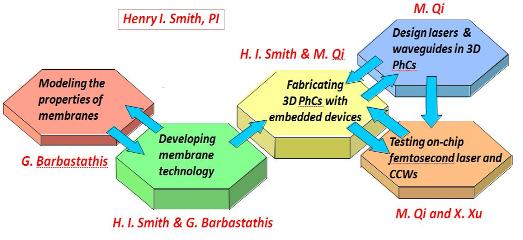
|
Program scope |
|
Our effort has two main foci: developing membrane technology, and fabricating 3D photonic crystals with embedded devices using membrane-stacking technology. We have extensive experience (since 1970) in forming, handling, bonding, transferring, patterning, aligning with nanometer-accuracy, folding, stacking, and characterizing nanomembranes, as well as nanostructures on or within membranes. Our results have defined the state-of-the-art. We will further refine the technologies and expand the applicable materials to include crystalline silicon and functional laser materials. These technology developments will culminate in the realization of high-quality, large-area 3D photonic crystals (PhCs) with designed microcavities and waveguides, which are the key components for on-chip femtosecond lasers and large-dispersion waveguides. In supporting the applications, modeling of the mechanical properties of membranes will be pursued, as well as the design of lasers and coupled-cavity waveguides in 3D photonic crystals. The testing of on-chip femtosecond lasers and coupled-resonator optical waveguides will start at a later time when prototype devices are available. Other novel technologies and devices that are uniquely enabled by our membrane technology, and not accessible by any other method, will be enabled. |

|
Conceptual organizational chart showing 2 major foci (Developing membrane technology, and Fabricating 3D photonic crystals with embedded devices ) and 3 supporting thrusts (modeling, design of devices and testing of on-chip devices) . Project leaders are shown in red for each thrust. |

|
Schematic depiction of a 3-D structure illustrating how a membrane, supporting a variety of electronic, photonic, spintronic, chemical or other devices, can be folded to maximize interfaces and interconnects; with signals traveling along the surface of the membrane, through it, and out to the external world. Heat could be carried away by passing a gas or liquid through the structure (i.e., perpendicular to the page). This topography is similar to that which has evolved in the brain and visual organs, with blood flow playing the role of coolant and the source of energy. This futuristic configuration is not meant to illustrate a specific system but rather the potential of membrane technology to maximize system functionality and compactness, while also providing for heat dissipation. It points to the necessity of developing technologies for working with membranes. |


